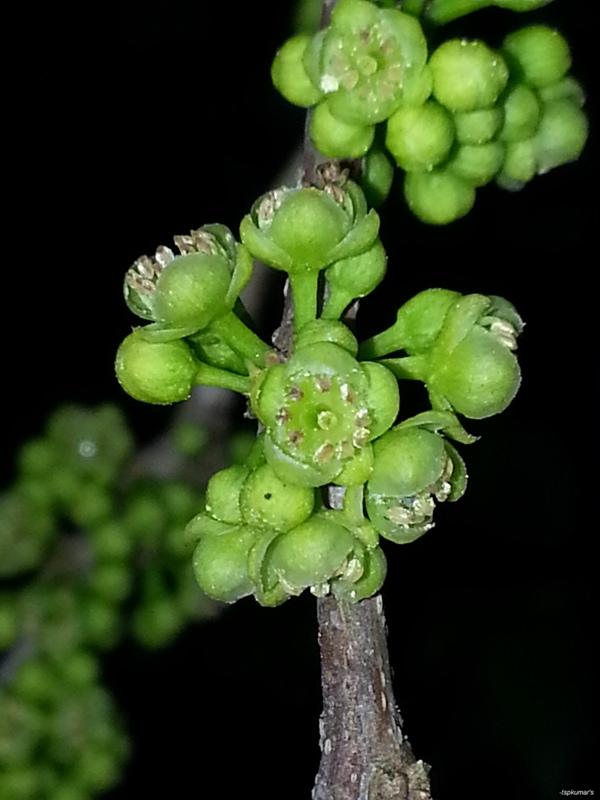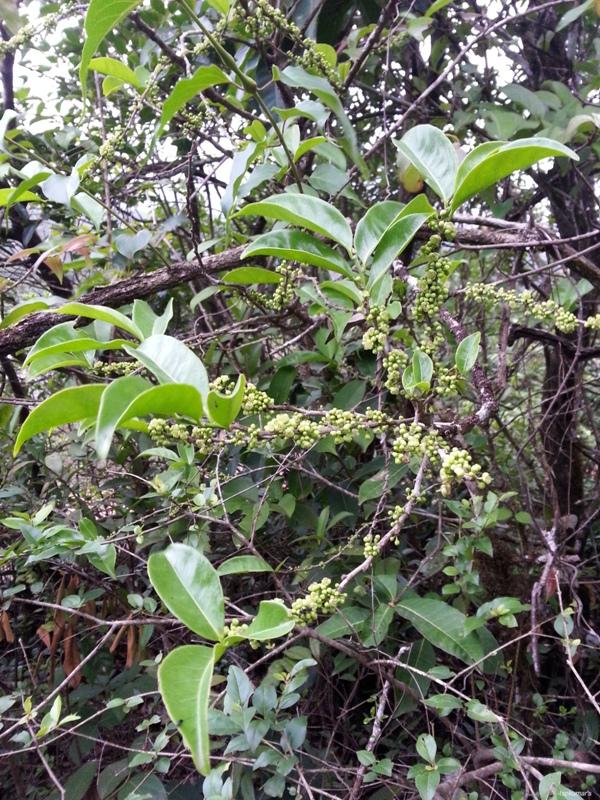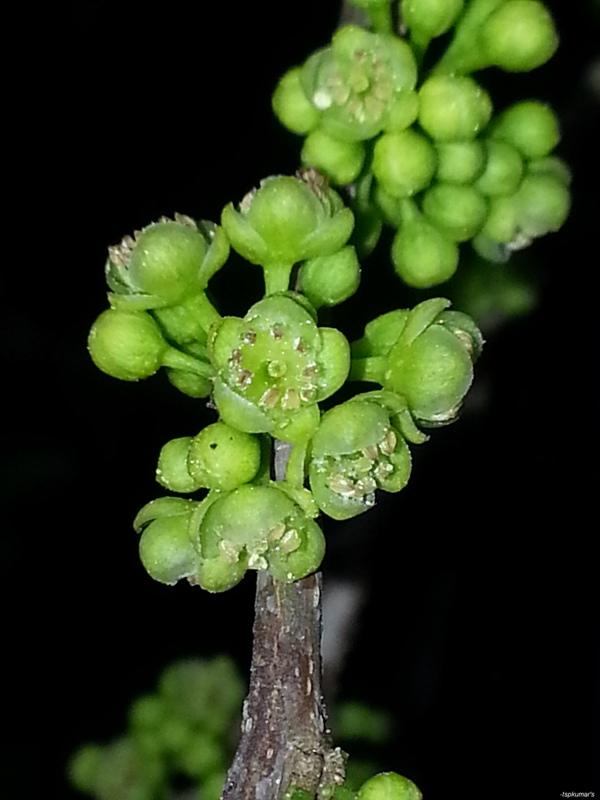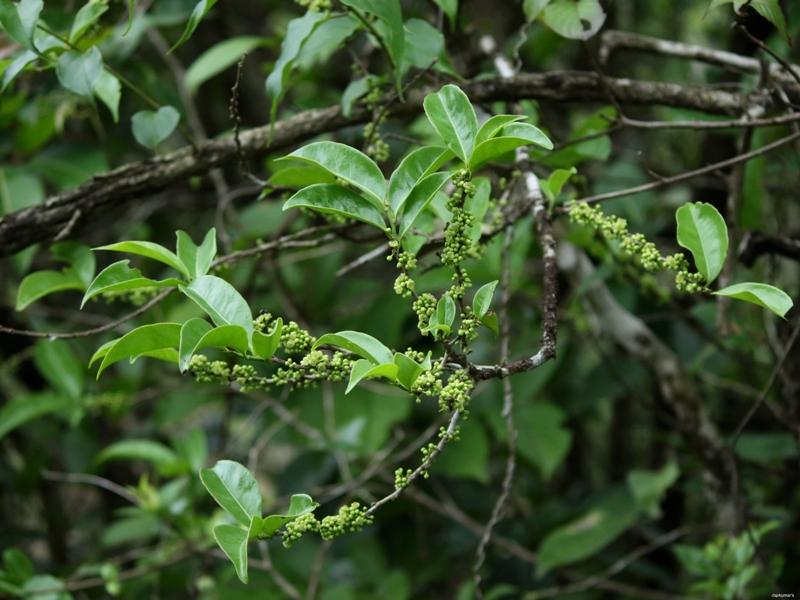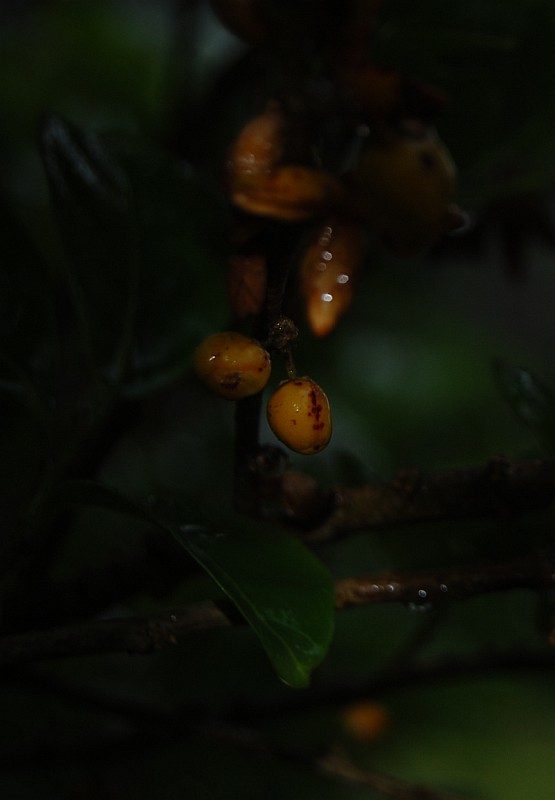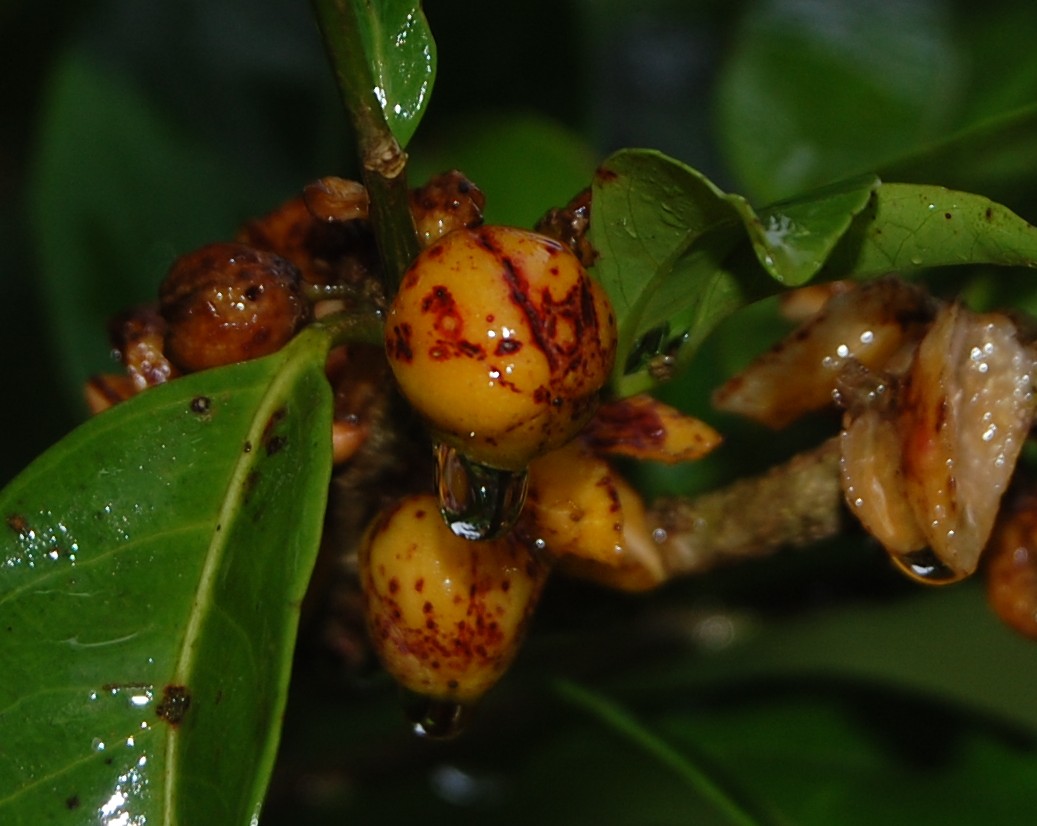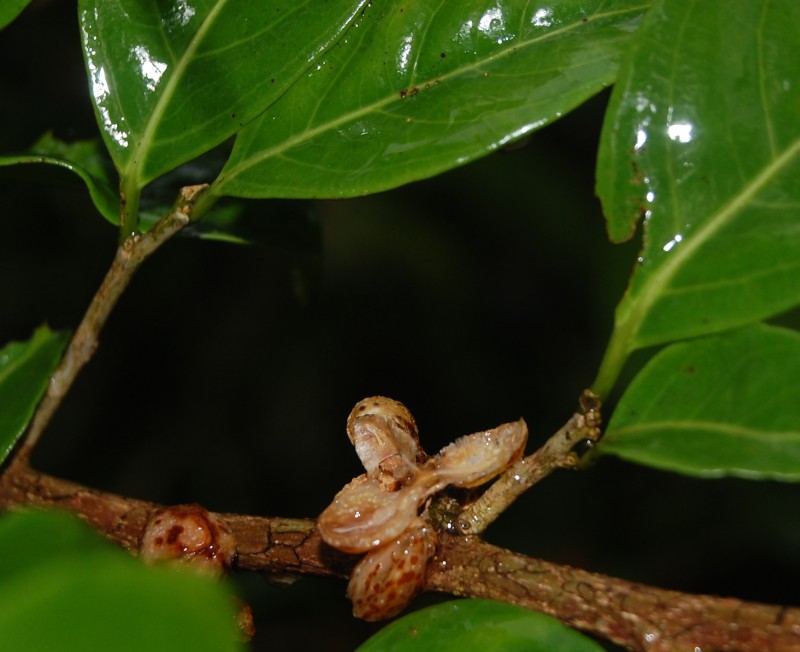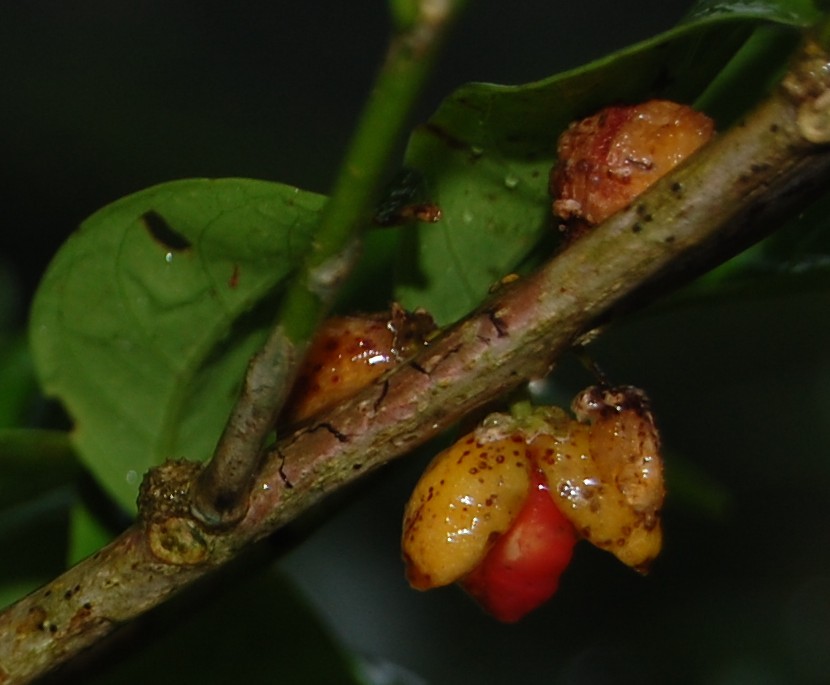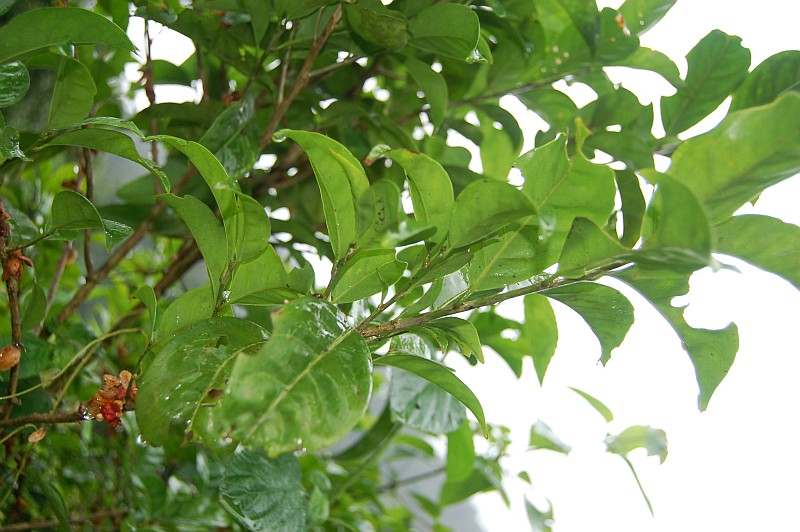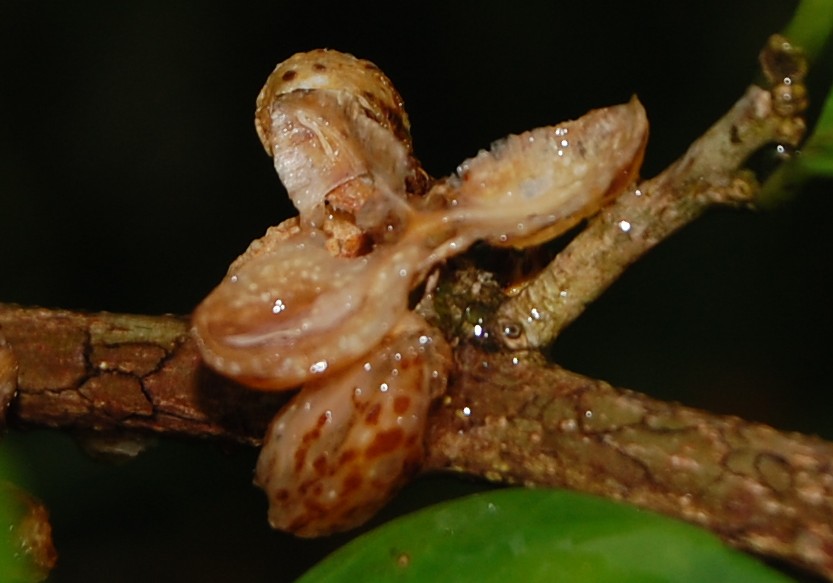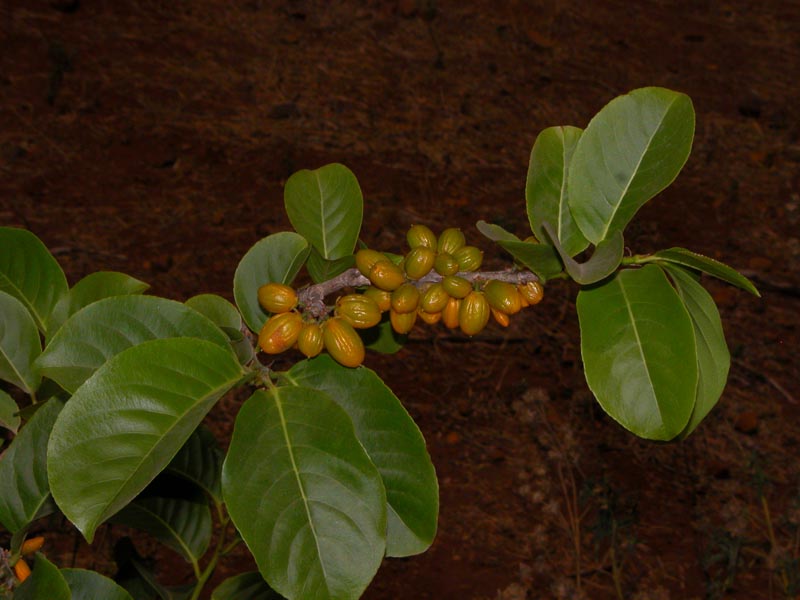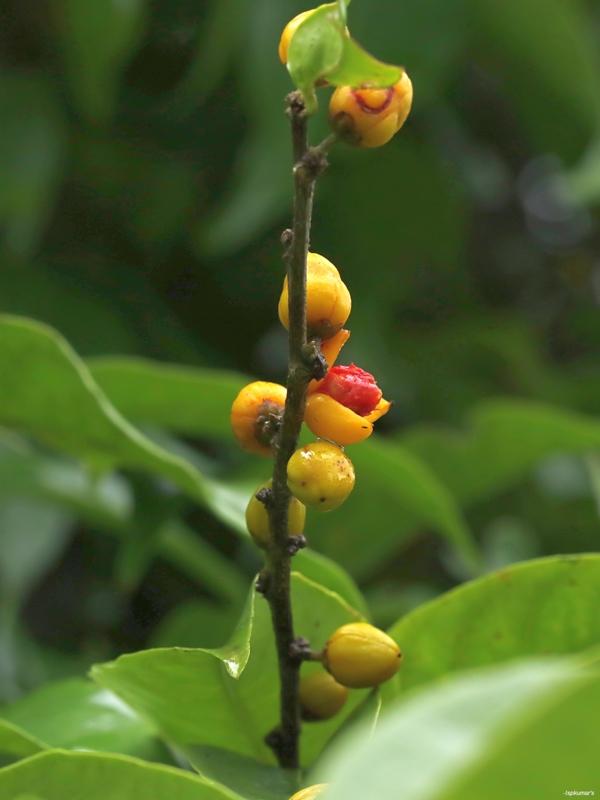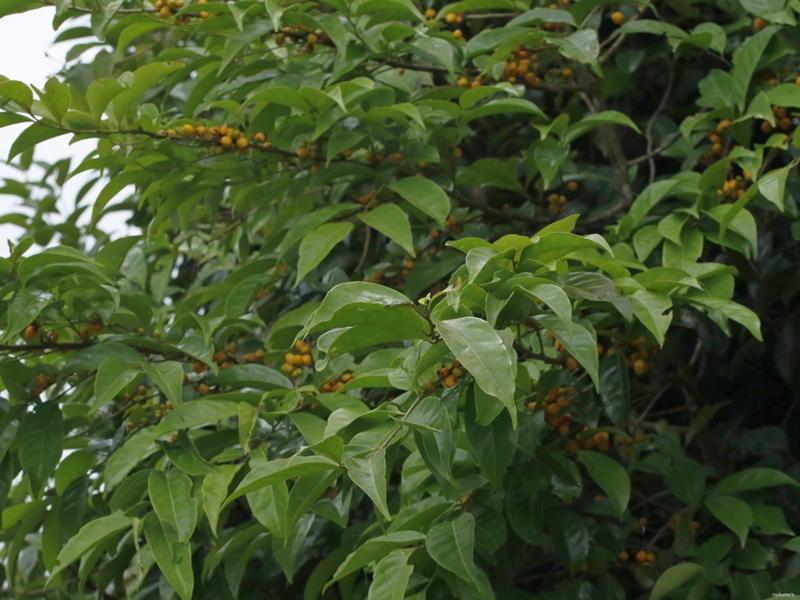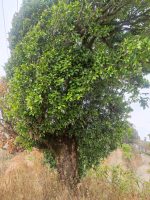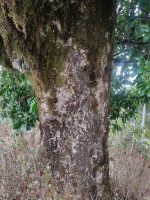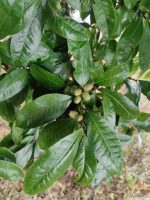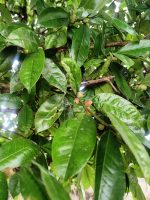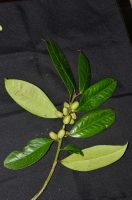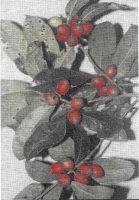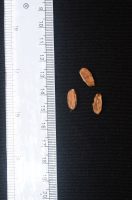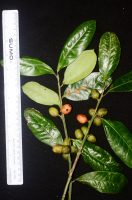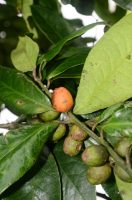|
Casearia zeylanica (Gaertn.) Thw., Enum. Pl. Zeyl. 19 1858. (syn: Casearia championii Thwaites; Casearia esculenta Roxb.; Casearia laevigata Dalzell; Casearia ovata var. minor (Thwaites) N.Mukh.; Casearia varians Thwaites; Guidonia esculenta (Roxb.) Baill.; Vareca zeylanica Gaertn.) as per POWO;
.
India (Andhra Pradesh, Tamil Nadu, Kerala), Sri Lanka, Myanmar [Burma] (Kachin), Bhutan as per Catalogue of Life;
.
Tamil: Kakkai-palai; Kolai aili; Gutti; Kottargovai Malayalam: Anavananki; Pannimurangam; Pannimurunga; Vella – kunnan; Malampavatta Kannada: Hillange; (Ref. Biotik)
.
commonly known as: casearia, esculent-leaved false kamela • Gujarati: ટંડોલ tandol • Hindi: सप्तरंगी saptrangi • Konkani: satagan • Malayalam: ചാറുക്കുന്നം cherukkunnam, മലമ്പാവെട്ട malampaavetta, വെള്ളക്കുന്നംvellakkunnam • Marathi: किरमीरा kirmira, कुळकुळटा kulkulta • Nepalese: thulo dedri • Sanskrit: सप्तचक्र saptachakra, स्वर्णमूलः svarnamulah • Tamil: காக்கைப்பலா kakkai-p-pala, குட்டி kutti • Telugu: కొండ గంగుడు konda gangudu ;
. Alagarkoil 121113 TBN 1 a for id : Attachments (4). 6 posts by 4 authors.
Please identify this plant details of which are as follows:
Date : 29.09.13
Location :Bison valley, Alagarkoil hill ranges, Natham taluk, Dindigul dt
Altitude :2250 ft
Habitat :reserve forest
Habit :straggler
Height :20 to 30 ft
Leaves :alternate
Flowers :as seen I think it is Casearia esculenta (now Guidonia esculenta). I too support … Flacourtiaceae. Thanks for the id. Is it a bird attracting native plant? . Salicaceae ( including Flacourtiaceae ) fortnight 1-14 Feb 2014 / Casearia esculenta / TBN Feb1 : 4 posts by 3 authors. Attachments (4).
Sending photos of Casearia esculenta identified by … and … in my previous mail dated 12.11.13
Date : 29.09.13
Location :Bison valley, Alagarkoil hill ranges, Natham tk, Dindigul dt
Altitude :2250 ft Habitat :Reserve forest Habit :straggler Height :20 to 30 ft
Leaves :alternate Flowers :as seen
Fruits :, Good pictures of Casearia esculenta
Kindly identify this tree with greenish sub-sessile flowers. Habit: A medium sized tree. Habitat: Wild, Evergreen forest. Sighting: Kottigehara, Chikmagalur, Karnataka, about 1200 msl Date: 20-05-2016 Casearia ovata (Lamk.) Willd. Matches with Casearia ovata ….Salicaceae……Thanks again …
Ref: http://florakarnataka.ces.iisc.ernet.in/hjcb2/herbsheet.php?id=2333&cat=1
Ref: /species/m—z/s/salicaceae/casearia/guidonia-ovata-lam-baill Saw this Glochidion flowering, request species ID, is it Glochidion ellipticum– Bhooma? Thank you.
This does not look like Glochidion ellipticum [G.hohenakeri]. Sending you some of my photographs of Bhoma for comparison [though they are not very clear]. I hope this plant is Glochidion ferdinandi commonly known as ” Cheese Tree”. Thanks …, not quite convincing, floral buds look different? Shall await further inputs. … some species of Casearia ? Looks like Casaeria Caesaria spp. are of Flacourtiaceae family; would this be? Thank you … for the possible ID. I looked for Caesaria sp. and once again looked up for Glochidion, could not resolve the ID. Shall await till someone can resolve it ! I think I can safely conclude this to be Casearia ovata (Lamk.) willd- Flacourtiaceae. The pictures and description match very well with Biotik data. It is Casearia ovata of FLACOURTIACEAE family
Glochidion ferdinandi is an Australian species.
http://en.wikipedia.org/wiki/Glochidion_ferdinandi Check for Garcinia sp.. May be Garcinia talbotii (Family: Clusiaceae).
It is not Garcinia. Garcinia is very peculiar with its leaf venation and Garcinia leaves are much thicker. Please check the characters for Casearia ovata (Flacaurtiaceae) in flora and herbarium . This plant is none other than Casearia ovata.
I think it should be Casearia zeylanica as per images and details herein. Casearia ovata at Matheran: Casearia ovata at Matheran: Touche’ ! Fair enough, but this tree definitely looks different from the shrub under discussion. I’m not clear, are you saying my pics are not Casearia ovata? My take – your tree is C.graveolens while the shrub discussed previously [and the ones on my property at Shahapur] are C.ovata. That’s interesting! Thank you. Will do more research on the relative distributions of these species. I think it should be Casearia zeylanica (Casearia esculenta Roxb.) as per images and details herein. I had taken Casearia ovata to be a synonym of C. esculenta according to sources available at the time. Yes, there seems to be a lot of confusion in the nomenclature, particularly Flora of Maharashtra.
But in this thread, Dr. Almeida himself has confirmed through …, that the current trend is veering towards considering both the same (Casearia graveolens Dalzell and Casearia ovata (Lam.) Willd.). This is also well supported by POWO and Flora of Eastern Ghats: Hill Ranges of South East India, Volume 1 By T. Pullaiah, D. Muralidhara Rao, K. Sri Ramamurthy (2007).
Casearia zeylanica (Casearia esculenta Roxb.) is different as per images and details herein. In Dr Almeida’s Flora of Maharashtra he has labelled the evergreen species C. ovata, with a description which matches perfectly. I do not know how the confusion has arisen, as to Casearia ovata aka C. esculenta.
But POWO and Flora of Eastern Ghats: Hill Ranges of South East India, Volume 1 By T. Pullaiah, D. Muralidhara Rao, K. Sri Ramamurthy (2007), seem to follow it correctly.
Maybe some good taxonomists, dealing with the matter, can explain.
SK1145 26 MAY 2018 : 5 posts by 2 authors. Attachments (7) – around 700 kb each.
Location: Soureni, India
Date: 7 May 2018
Altitude: 4000 ft
Habit : Wild
Casearia graveolens Dalzell ?? I also think closer to images at Casearia graveolens I found inflorescence to much more hairy compared to those of other images at Casearia graveolens
It should be Casearia glomerata Roxburgh as per keys at Flora of China, as stipules are clearly triangular and minute and not lanceolate as in Casearia graveolens.
Seem more of Casearia zeylanica Tanks, … But I find it different from images and details at Casearia zeylanica (Gaertn.) Thw. On further checking, I also feel that you may be right.
Monsoon 2011 – Making a magical flora discovery in rainy Coorg ( Part 3)
(Perhaps a Wild Nutmeg, Knema attenuata, Myristicaceae family)
Rainy season is the best time to visit Coorg, blanketing the place as it does in shades of green, be it lush forests,
mountaintops and every other spot. Bhagmandala, the place where the three rivers, the Kaveri Kannike and Sujyothi merge is no exception and one fine day at the height of the monsoon season, we walked the woody paths in Bhagmandala. The drizzle had set in by afternoon, continuing into the evening when suddenly it took on the shape of a downpour. We retreated to the shelter of the nearby trees and what do we find here but that hidden in the dark and dense vegetation were these spectacular young red flowers. We had hit a jackpot! …..
1. Tolypanthus lagenifer– [Indian Tolypanthus] from the Family Loranthaceae,
2. Cup and Saucer plant [Breynia retusa] -already posted, 3. Id request – (This email))
(Perhaps a Wild Nutmeg, Knema attenuata, Myristicaceae family. I have to check the bot. desc. in detail)
Bhagamandala, Coorg
27 July 2011 16;24
Western ghats
Write up posted earlier
Wonderful. I wish I should have been there with you. Last week when I visited Tala Kaveri and Bhaghamandala were experiencing heavy showers and during intermission the whole place was covered with fog and we could not see 10 ft ahead without light. But we enjoyed the beauty of the place . This reminded me of San Francisco (fog city) This is not Knema attenuata. Sir, this is probably Knema attenuata only. Please refer @ http://www.biotik.org/india/species/k/knematte/knematte_en.html
Please note the leaves. you are right. THERE ARE 8 SPECIES OF CASEARIA SPS TREES. SHARP PICS OF LEAVES AND FRUITS GREATLY HELP IN ID.PL. SEE MY LATEST BOOK ‘FOREST TREES OF THE WESTERN AND EASTERN GHATS. I think it should be Casearia zeylanica (Casearia esculenta Roxb.) as per images and details herein. SK574 17 JUN-2017:ID : 12 posts by 4 authors. Attachments (9) Location: Soureni, Mirik, India
Date: 18 May 2017
Altitude: 4200 ft.
A species of Casearia Casearia graveolens Dalzell ?? efi page on Casearia graveolens with images I have now checked with available images, keys and descriptions and this appears to me to be Casearia graveolens Thank you … Casearia graveolens Dalzell I think it should be Casearia zeylanica (Casearia esculenta Roxb.) as per images and details herein. Casearia zeylanica is not found in NE India, according to the distribution map at POWO. Even I could not find its distribution in West Bengal in any links. However, could it be Casearia graveolens, which is distributed in NE India? That was ID earlier. It is from Soureni, Mirik, India, which is very close to Bhutan, where it is reported as per Catalogue of Life. Triangular minute stipules are clearly seen in the new leaves– thus can not be Casearia graveolens
Salicaceae (including Flacourtiaceae) Fortnight: Casearia esculanta Near Bhor. Mah : 2 images. 2 posts by 2 authors.
Casearia esculanta Well done. . For ID…………?Salvadora. Probably some Tabernaemontana sp. (Apocynaceae family). I had seen this plant at Phansad WLS. Please confirm. It is Casearia esculenta locally called Kirmira or Kulkulta. Here is a link for details:
http://www.ayushveda.com/herbs/casearia-esculenta.htm . Salicaceae (including Flacourtiaceae) Fortnight: Casearia esculanta Near Bhor. Mah : 3 posts by 3 authors. 2 images.
Casearia esculanta Well done. Salicaceae ( including Flacourtiaceae) fortnight: Casearia ovata from Matheran RV1 : 7 posts by 5 authors. Attachments (7).
Casearia ovata (Lamk.) Willd syn. Casearia esculenta Roxb. from Matheran.
A small tree in the understorey of evergreen forest on the plateau.
Flowering in July and fruiting in September- October.
According to the Plant List this tree is now known as Guidonia ovata (Lam) Baill. Excellent images … Thank you …, it is difficult to get good flower pictures during the heavy monsoon at that time. Beautiful presentation. Thanks, …, for the wonderful images.
I think it should be Casearia zeylanica (Casearia esculenta Roxb.) as per images and details herein.
In this thread, Dr. Almeida himself has confirmed through …, that the current trend is veering towards considering both the same (Casearia graveolens Dalzell and Casearia ovata (Lam.) Willd.). This is also well supported by POWO and Flora of Eastern Ghats: Hill Ranges of South East India, Volume 1 By T. Pullaiah, D. Muralidhara Rao, K. Sri Ramamurthy (2007). 165-TSP-ID-05FEB2018-2: A medium sized tree near Sakaleshpur for ID assistance : 8 posts by 4 authors. Attachments (3)
Kindly examine and identify this Tree. Habit: A medium sized tree. Habitat: Wild, Evergreen forest Sighting: Near Sakaleshpur,Karnataka,about 1000 msl Date: 03-08-2018 Casearia ovata Doubtful ID.
I also think close to images at Casearia ovata as per id by …
I think it should be Casearia zeylanica (Casearia esculenta Roxb.) as per images and details herein.
In this thread, Dr. Almeida himself has confirmed through …, that the current trend is veering towards considering both the same (Casearia graveolens Dalzell and Casearia ovata (Lam.) Willd.). This is also well supported by POWO and Flora of Eastern Ghats: Hill Ranges of South East India, Volume 1 By T. Pullaiah, D. Muralidhara Rao, K. Sri Ramamurthy (2007). .
Altitude : ca.1,500 m
Date : 04-04-2023
Habit : Tree
Habitat : Wild
Casearia ?? Pl. post the keys.
Any keys?
Casearia ?? The genus Casearia is not found in the Flora of Mizoram. I think this appears close to images at
https://efloraofindia.com/2020/07/12/casearia-zeylanica/ |
Casearia zeylanica
Updated on December 24, 2024

